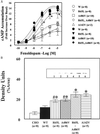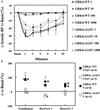G protein-coupled receptor kinase 4 gene variants in human essential hypertension
- PMID: 11904438
- PMCID: PMC122616
- DOI: 10.1073/pnas.062694599
G protein-coupled receptor kinase 4 gene variants in human essential hypertension
Abstract
Essential hypertension has a heritability as high as 30-50%, but its genetic cause(s) has not been determined despite intensive investigation. The renal dopaminergic system exerts a pivotal role in maintaining fluid and electrolyte balance and participates in the pathogenesis of genetic hypertension. In genetic hypertension, the ability of dopamine and D(1)-like agonists to increase urinary sodium excretion is impaired. A defective coupling between the D(1) dopamine receptor and the G protein/effector enzyme complex in the proximal tubule of the kidney is the cause of the impaired renal dopaminergic action in genetic rodent and human essential hypertension. We now report that, in human essential hypertension, single nucleotide polymorphisms of a G protein-coupled receptor kinase, GRK4gamma, increase G protein-coupled receptor kinase (GRK) activity and cause the serine phosphorylation and uncoupling of the D(1) receptor from its G protein/effector enzyme complex in the renal proximal tubule and in transfected Chinese hamster ovary cells. Moreover, expressing GRK4gammaA142V but not the wild-type gene in transgenic mice produces hypertension and impairs the diuretic and natriuretic but not the hypotensive effects of D(1)-like agonist stimulation. These findings provide a mechanism for the D(1) receptor coupling defect in the kidney and may explain the inability of the kidney to properly excrete sodium in genetic hypertension.
Figures





Similar articles
-
[G protein kinase 4gammaA142V overexpression induced hypertension by downregulating D1 receptors in transgenic mice].Zhonghua Xin Xue Guan Bing Za Zhi. 2006 May;34(5):411-4. Zhonghua Xin Xue Guan Bing Za Zhi. 2006. PMID: 16776954 Chinese.
-
Desensitization of human renal D1 dopamine receptors by G protein-coupled receptor kinase 4.Kidney Int. 2002 Sep;62(3):790-8. doi: 10.1046/j.1523-1755.2002.00525.x. Kidney Int. 2002. PMID: 12164861
-
Mechanisms of disease: the role of GRK4 in the etiology of essential hypertension and salt sensitivity.Nat Clin Pract Nephrol. 2006 Nov;2(11):637-50. doi: 10.1038/ncpneph0301. Nat Clin Pract Nephrol. 2006. PMID: 17066056
-
Dopamine receptor-coupling defect in hypertension.Curr Hypertens Rep. 2002 Jun;4(3):237-44. doi: 10.1007/s11906-002-0013-6. Curr Hypertens Rep. 2002. PMID: 12003707 Review.
-
Dopamine and G protein-coupled receptor kinase 4 in the kidney: role in blood pressure regulation.Biochim Biophys Acta. 2010 Dec;1802(12):1259-67. doi: 10.1016/j.bbadis.2010.02.004. Epub 2010 Feb 12. Biochim Biophys Acta. 2010. PMID: 20153824 Free PMC article. Review.
Cited by
-
A linear relationship between the ex-vivo sodium mediated expression of two sodium regulatory pathways as a surrogate marker of salt sensitivity of blood pressure in exfoliated human renal proximal tubule cells: the virtual renal biopsy.Clin Chim Acta. 2013 Jun 5;421:236-42. doi: 10.1016/j.cca.2013.02.021. Epub 2013 Feb 27. Clin Chim Acta. 2013. PMID: 23454474 Free PMC article.
-
Hypertension-Related Gene Polymorphisms of G-Protein-Coupled Receptor Kinase 4 Are Associated with NT-proBNP Concentration in Normotensive Healthy Adults.Int J Hypertens. 2012;2012:806810. doi: 10.1155/2012/806810. Epub 2012 Feb 21. Int J Hypertens. 2012. PMID: 22518293 Free PMC article.
-
Synergistic Effect of Uroguanylin and D1 Dopamine Receptors on Sodium Excretion in Hypertension.J Am Heart Assoc. 2022 Mar 15;11(6):e022827. doi: 10.1161/JAHA.121.022827. Epub 2022 Mar 1. J Am Heart Assoc. 2022. PMID: 35229618 Free PMC article.
-
Potential dopamine-1 receptor stimulation in hypertension management.Curr Hypertens Rep. 2011 Aug;13(4):294-302. doi: 10.1007/s11906-011-0211-1. Curr Hypertens Rep. 2011. PMID: 21633929 Review.
-
G Protein-Coupled Receptor Kinases in the Inflammatory Response and Signaling.Adv Immunol. 2017;136:227-277. doi: 10.1016/bs.ai.2017.05.003. Epub 2017 Jun 10. Adv Immunol. 2017. PMID: 28950947 Free PMC article. Review.
References
-
- Guyton A C. Circulatory Physiology III: Arterial Pressure and Hypertension. Philadelphia: Saunders; 1980.
-
- Guidi E, Menghetti D, Milani S, Montagnino G, Plazzi O, Bianchi G. J Am Soc Nephrol. 1996;7:1131–1138. - PubMed
-
- Jose P A, Eisner G M, Felder R A. Pharmacol Ther. 1998;80:149–182. - PubMed
-
- Hegde S S, Jadhav A L, Lokhandwala M F. Hypertension. 1989;13:828–834. - PubMed
-
- Felder R A, Seikaly M G, Cody P, Eisner G M, Jose P A. Hypertension. 1990;15:560–569. - PubMed
Publication types
MeSH terms
Substances
LinkOut - more resources
Full Text Sources
Other Literature Sources
Medical
Molecular Biology Databases

